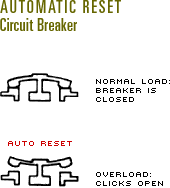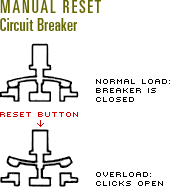
Typical double–break automatic device
In order to maintain the current, in the closed position the conductive snap–acting disc (with its contacts)
bridges the terminal contacts. At predetermined overloads, the resistance heat (caused by current passing through
the disc) snaps the disc into reverse position. This opens the contacts and breaks the circuit. After a short
cooling time the disc automatically closes and re–establishes the circuit.
If the overload conditions persist, the breaker automatically reopens and continues the cycle again. After the
overload conditions have been corrected the breaker will remain closed until the next overload.
|

Typical double–break manual device
In comparable sizes, the only visual difference between Klixon manual and automatic resetting circuit breakers is that
the manual version has a reset button.
Operation is also similar except that when the disc has snapped into reverse position, the contacts open and remain open
until manually reset by the pushbutton. In resetting these units, the pushbutton moves inward only while pushed and always
returns to the same position when released.
All breakers are “trip–free”, meaning that their contacts cannot be held in the closed position by the reset button
if overload conditions persist.
|